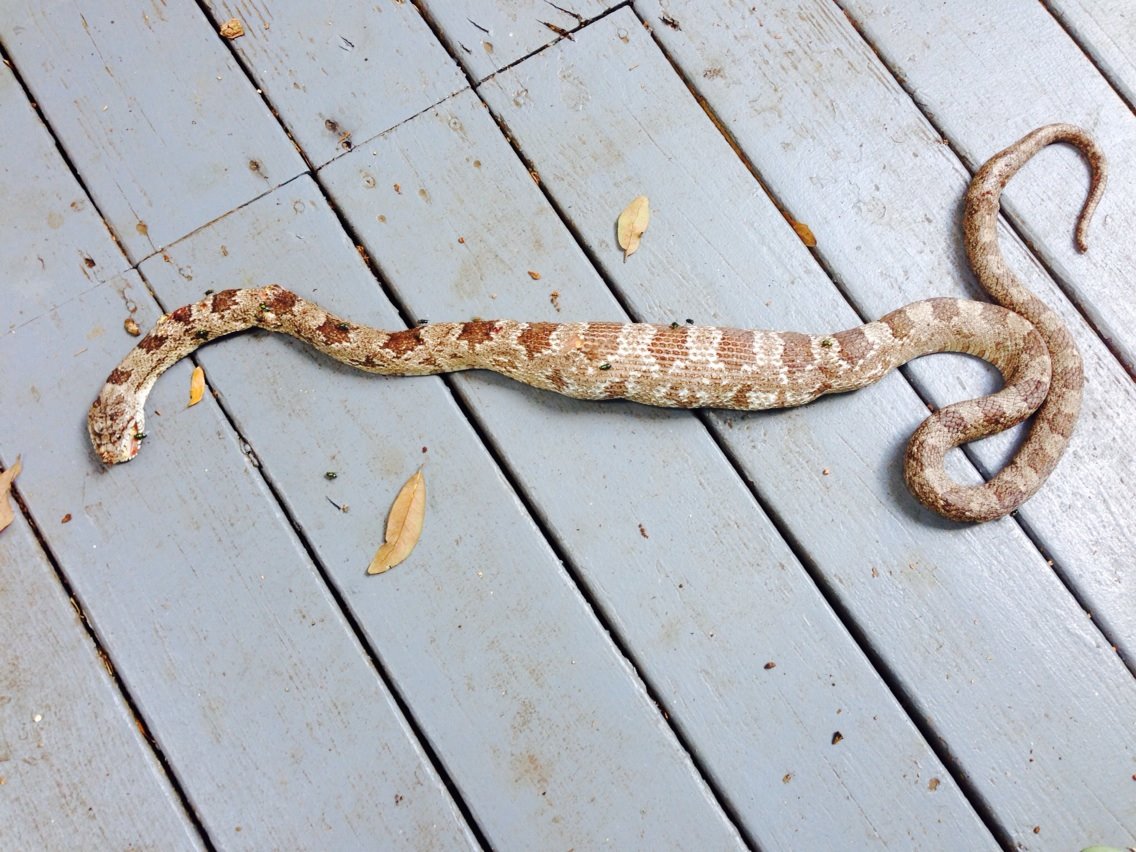

[avatar user=”brennanleathers” align=”left”]Brennan Leathers[/avatar]
I will admit–I don’t know much about snakes–which markings go with which species, which ones are poisonous. I am not exactly scared of snakes, but I keep my distance from them.
So when a Facebook friend of mine, Dr. Heidi Chambers–an English teacher at Bainbridge High School–posted pictures of a dead snake asking what kind of species it was, I was a little alarmed. It looked similar to an Eastern diamondback rattlesnake to me.
Even more interesting, this snake was dispatched by Chambers’ grandmother, Isobel Odegaard of Bainbridge, who is 92 years old.
Chambers had explained that her grandmother–who still exercises regularly–went after the snake with a big stick after she discovered the snake eating one of her “pet” squirrels. Apparently, Mrs. Odegaard likes to feed some of the squirrels in her yard and they have since became accustomed to getting a daily snack.
“She has about six that come to her house,” Chambers explained. “She feeds them bird food. It all started when the squirrels were getting into her bird feeders and she decided they needed to eat too.”
Unfortunately, the squirrels coming up on the porch may have attracted the snake, which was identified by helpful Facebook posters as an “oak snake,” officially known as a gray rat snake. It’s a rat snake…squirrels are rodents…you see how this situation came about.
Now some of you might not see what the big deal is. There is a certain sort of person–myself included–who can’t stand to see any kind of animal abandoned or in harm’s way. I have taken multiple stray cats, mewling in the rainy darkness, to shelters or foster homes. I also took what I thought was a baby squirrel, abandoned by its parents, to the St. Francis Wildlife Refuge in Gadsden County, Fla., only to learn that it was just a baby rat.
Back to Mrs. Odegaard, who called Heidi on the phone to tell her there was a snake on the porch. Dr. Chambers said she told her grandmother not to do anything but watch it, but granddaughter Emily correctly surmised that her grandmother was not likely to leave the snake be, especially if it was harassing her squirrel friend. You see, this wasn’t Isobel’s first wrangling with a snake. A while back, she dispatched a small garden snake with a hammer.
The oak snake was larger, about 2+ feet long fully extended by looking at the picture. According to a page on Phil’s Natural World titled “Non-Poisonous Snakes of Florida,” young oak snakes are 11-17 inches long and adults can reach between 36-72 inches (three to six feet). They are found throughout the Florida Panhandle (I assume Bainbridge is close enough to its habitat) and survive on a diet of rodents and birds.
This time, Mrs. Odegaard beat the snake to death with a large stick. It was on her porch, after all, and it had attacked one of her “pets.” I don’t blame her. Many women I know would have already called for someone to come shoot it–local police and Sheriff’s deputies get calls all the time about snakes in people’s outdoor laundry rooms and under porches. Some of those snakes get dispatched by bullet or relocated to the nearest creek.
Which brings up the question: How was the squirrel slow enough to be attacked by the oak snake? At first Mrs. Odegaard thought the oak snake’s victim was one of the squirrels that had a lame leg. Nope, that one was back the day after the snake was killed. However, the snake had clearly been enjoying its last meal–take a look at the “belly” of the snake in this picture.
I tell you what, I have to give Mrs. Odegaard kudos for still being active at the age of 92. And I certainly sympathize with her for wanting to protect some of her little furry friends, even if the snake didn’t know any better. But most of all, way to go Mrs. Mrs. Odegaard, for showing that women don’t have to be scared of snakes, as Eve was cursed with in the Bible.
Special thanks to Heidi Chambers for allowing us to share this story with our viewers and listeners.





Be the first to comment